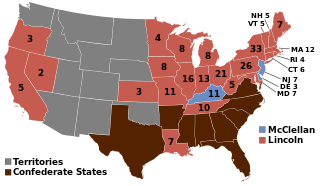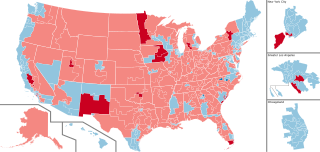
An election is a formal group decision-making process by which a population chooses an individual or multiple individuals to hold public office.

Google Search is a search engine operated by Google. It allows users to search for information on the Web by entering keywords or phrases. Google Search uses algorithms to analyze and rank websites based on their relevance to the search query. It is the most popular search engine worldwide.

The 1864 United States presidential election was the 20th quadrennial presidential election. It was held on Tuesday, November 8, 1864. Near the end of the American Civil War, incumbent President Abraham Lincoln of the National Union Party easily defeated the Democratic nominee, former General George B. McClellan, by a wide margin of 212–21 in the electoral college, with 55% of the popular vote. For the election, the Republican Party and some Democrats created the National Union Party, especially to attract War Democrats.

The 1924 United States presidential election was the 35th quadrennial presidential election, held on Tuesday, November 4, 1924. In a threeway contest, incumbent Republican President Calvin Coolidge won election to a full term. Coolidge was the second vice president, after Theodore Roosevelt, to ascend to the presidency and then win a full term.

Óscar Gutiérrez Rubio, better known by his ring name Rey Mysterio, is an American professional wrestler. He is signed to WWE, where he performs on the Raw brand. Widely regarded as one of the greatest cruiserweight wrestlers of all time, Mysterio is an inductee of the AAA Hall of Fame, Wrestling Observer Newsletter Hall of Fame, and WWE Hall of Fame.

Paul Michael Levesque, better known by the ring name Triple H, is an American business executive, actor, and retired professional wrestler. Regarded as one of the greatest professional wrestlers of all time, he is the Chief Content Officer for WWE, a subsidiary of TKO Group Holdings.

Glenn Thomas Jacobs, also known by his ring name Kane, is an American politician, actor and professional wrestler. He rose to fame in WWE and is regarded as one of the greatest professional wrestlers of his generation. In 2018, he became the mayor of Knox County, Tennessee.

John Felix Anthony Cena is an American actor and professional wrestler. As a wrestler, he has been signed to WWE since 2001, but has performed part-time since 2018. A record 16-time world champion as recognized by WWE alongside Ric Flair, he is widely regarded as one of the greatest professional wrestlers of all time.

Dixville Notch is an unincorporated community in Dixville township, Coos County, New Hampshire, United States. The population of the township, all of whom live in Dixville Notch, was 4 as of the 2020 census. The village is known for being the first place to declare its results during the New Hampshire presidential primary. It is located in the northern part of the state, approximately 20 miles (32 km) south of the border with the Canadian province of Quebec. The village is situated at about 1,800 feet (550 m) above sea level at the base of mountains.

Leati Joseph "Joe" Anoaʻi, better known by his ring name Roman Reigns, is an American professional wrestler and former football player. He is signed to WWE, where he performs on the SmackDown brand. He is the leader of the babyface iteration of The Bloodline stable and a member of the Anoaʻi family. Reigns's title reign of 1,316 days as Undisputed WWE Universal Heavyweight Champion was the fourth-longest world title reign in WWE history and the longest championship reign since 1988. He is widely regarded as one of the best professional wrestlers currently active in the world, and by some as one of the greatest professional wrestlers of all time.

Cody Garrett Runnels Rhodes is an American professional wrestler and actor. As a wrestler, he has been signed to WWE since March 2022, where he performs on the SmackDown brand and is the current Undisputed WWE Champion, recognized as both the WWE Champion and WWE Universal Champion in his first reign with each, as well as the inaugural WWE Crown Jewel Champion. He is also known for his time in All Elite Wrestling (AEW), where he was an Executive Vice President and co-founder when the company was founded in 2019 until he left in 2022.

Presidential primaries and caucuses were organized by the Democratic Party to select the 4,051 delegates to the 2016 Democratic National Convention held July 25–28 and determine the nominee for President in the 2016 United States presidential election. The elections took place within all fifty U.S. states, the District of Columbia, five U.S. territories, and Democrats Abroad and occurred between February 1 and June 14, 2016. Between 2008 and 2020, this was the only Democratic Party primary in which the nominee had never been nor had ever become President of the United States. This was the first Democratic primary to nominate a woman for President.

The 2016 United States House of Representatives elections were held on November 8, 2016, to elect representatives for all 435 congressional districts across each of the 50 U.S. states to the 115th United States Congress. Non-voting members for the District of Columbia and territories of the United States were also elected. These elections coincided with the election of President Donald Trump, although his party lost seats in both chambers of Congress. The winners of this election served in the 115th Congress, with seats apportioned among the states based on the 2010 United States census. In October 2015, the House elected a new Speaker, Republican Paul Ryan, who was re-elected in the new term. Democrat Nancy Pelosi continued to lead her party as Minority Leader. Elections were also held on the same day for the U.S. Senate, many governors, and other state and local elections.

The 2016 United States presidential election in California was held on Tuesday, November 8, 2016, as part of the 2016 United States presidential election in which all 50 states plus the District of Columbia participated. California voters chose electors to represent them in the Electoral College via a popular vote, pitting the Republican Party's nominee, businessman Donald Trump, and running mate Indiana Governor Mike Pence against Democratic Party nominee, former Secretary of State Hillary Clinton, and her running mate Virginia Senator Tim Kaine. California had 55 electoral votes in the Electoral College, the most of any state.

The 2018 United States House of Representatives elections were held on November 6, 2018, as part of the 2018 midterm elections during President Donald Trump's term, with early voting taking place in some states in the weeks preceding that date. Voters chose representatives from all 435 congressional districts across each of the 50 U.S. states to serve in the 116th United States Congress. Non-voting delegates from the District of Columbia and four of the five inhabited U.S. territories were also elected. On Election Day, Republicans had held a House majority since January 2011.

The 2020 United States House of Representatives elections were held on November 3, 2020, to elect representatives from all 435 congressional districts across each of the 50 U.S. states to the 117th United States Congress, as well as six non-voting delegates from the District of Columbia and the inhabited U.S. territories. Special House elections were also held on various dates throughout 2020.

The 2022 United States House of Representatives elections were held on November 8, 2022, as part of the 2022 United States elections during incumbent president Joe Biden's term. Representatives were elected from all 435 U.S. congressional districts across each of the 50 states to serve in the 118th United States Congress, as well as 5 non-voting members of the U.S. House of Representatives from the District of Columbia and four of the five inhabited insular areas. Numerous other federal, state, and local elections, including the 2022 U.S. Senate elections and the 2022 U.S. gubernatorial elections, were also held simultaneously. This was the first election after the 2020 redistricting cycle.

The 2020 United States presidential election in Iowa was held on Tuesday, November 3, 2020, as part of the 2020 United States presidential election in which all 50 states plus the District of Columbia participated. Iowa voters chose electors to represent them in the Electoral College via a popular vote, pitting the Republican Party's nominee, incumbent President Donald Trump of Florida, and running mate Vice President Mike Pence of Indiana against Democratic Party nominee, former Vice President Joe Biden of Delaware, and his running mate California Senator Kamala Harris. Iowa has six electoral votes in the Electoral College.

The 2020 United States presidential election in Ohio was held on Tuesday, November 3, 2020, as part of the 2020 United States presidential election in which all 50 states plus the District of Columbia participated. Ohio voters chose electors to represent them in the Electoral College via a popular vote, pitting the Democratic Party nominee, former Vice President Joe Biden and his running mate, California Senator Kamala Harris against the Republican Party's nominee—incumbent President Donald Trump and his running mate, Vice President Mike Pence. Ohio had 18 electoral votes in the Electoral College.

The 2023 United States elections were held, in large part, on Tuesday, November 7, 2023. The off-year election included gubernatorial and state legislative elections in a few states, as well as numerous citizen initiatives, mayoral races, and a variety of other local offices on the ballot. At least three special elections to the United States Congress were scheduled as either deaths or vacancies arose. The Democratic Party retained control of the governorship in Kentucky, flipped the Wisconsin Supreme Court and held a seat on the Pennsylvania Supreme Court, gained six seats in the New Jersey General Assembly, and won back unified control of the Virginia General Assembly, while Republicans also flipped the governorship in Louisiana and narrowly retained Mississippi's governorship. The election cycle also saw Ohio voting to enshrine abortion rights in the state constitution and legalize cannabis for recreational use. The results were widely seen as a success for the Democratic Party.




















